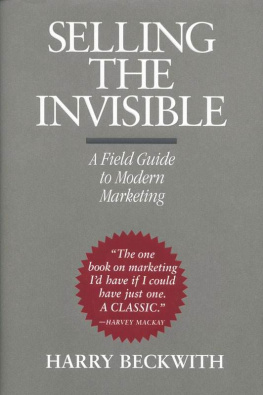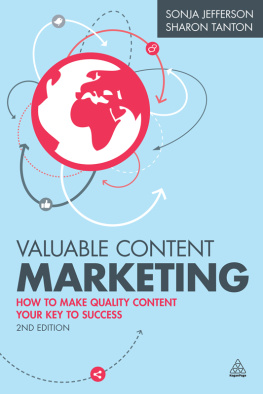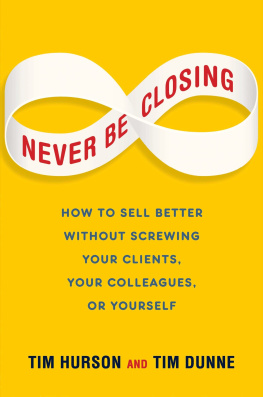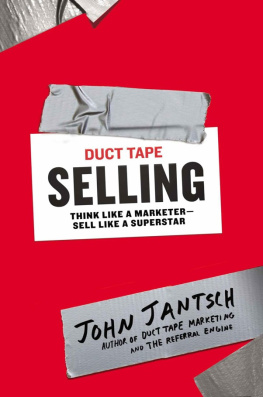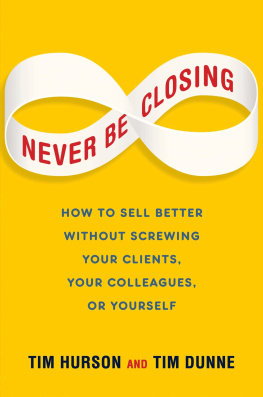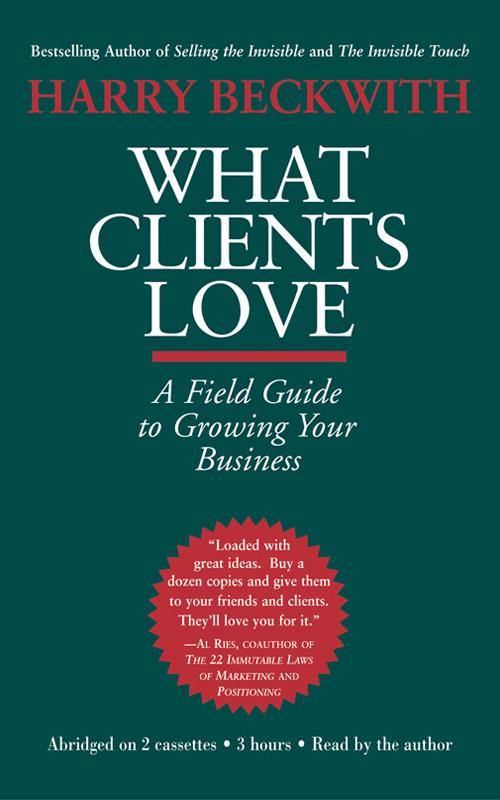This publication is designed to provide competent and reliable information regarding the subject matter covered. However, it is sold with the understanding that the author and publisher are not engaged in rendering legal, financial, or other professional advice. Laws and practices often vary from state to state and if legal or other expert assistance is required, the services of a professional should be sought. The author and publisher specifically disclaim any liability that is incurred from the use or application of the contents of this book.
Copyright 2003 by Harry Beckwith
All rights reserved.
Warner Books
Hachette Book Group
237 Park Avenue
New York, NY 10017
Visit our website at www.HachetteBookGroup.com.
First eBook Edition: January 2003
ISBN: 978-0-7595-2734-8
To you
Dad,
for proving
you were possible.
Introduction: A Lesson
from the Road
This book offers a pleasant alternative to learning from your mistakes:
Learn from mine.
My mistakes began with Selling the Invisible. Because clients love experts and no one looks more expert than an author, many people called me after the book appeared, often with invitations to speak to their companies. Naturally, I accepted.
I went. I spoke. I bombed.
I flew to Miami to address a leading telecommunications firm. I covered the subjects the employees had loved in the book, but the number of people checking their watches seemed a bad sign. I stumbled on until the clock mercifully signaled the end.
My host grabbed my arm as I staggered from the podium and promised a postmortem in a few minutes. I waited for him in the hotel lobby as the audience members filed by me as if I were hosting a virus. Minutes later my client appeared, sat down at the lobby table, and began the background for this book.
Good material, really. But let me give you a tip.
You mispronounced our presidents name. Three times. That threw everyone off.
I had made the president and his company sound as if they did not matter to me. The employees felt slighted, and because of that, they did not like me and my speech.
Off to Chicago to talk to some food distributors. Again I covered the content they had loved in the book and correctly pronounced their key peoples names. They responded better, but dozens of decibels short of a big ovation.
I knew why as I sat back down. I had viewed the audience as my enemy. I resented their power to judge me; they were blockading my romp to happiness.
Because I resented them, many of them felt uncomfortable; something seemed offand because of that, my speech did, too. Clients feel about a service the way they feel about the provider.
Next stop, Tucson, I was determined to like that audience. I even carried a Post-it to the podium that read: Engage, Help, Smile.
This seemed to work. Everyone listened, laughed, and teared up at the sentimental moments. My slump had ended.
No, it hadnt.
After hearing many compliments as I left the meeting room, I walked through the hotel lobby and down a corridor to the gift shop. I had just started to study a stuffed javelina when a man with a sticker that read Bend, Oregon, beelined toward me with what I assumed would be a compliment.
Right up to the end you were a 10. You had us in your palms, he said. Then you mentioned being divorced. After that, it was a 1. Ruined everything.
Who was this person who could be sidetracked by something so irrelevant?
A typical client.
In this new world, technical skills matter; they pay the entry fees. But many clients can afford that fee, and most clients cannot distinguish one firms skill from anothers. Competence gets firms into a game that relationships win.
My first book discussed the importance of relationships briefly. My fingers may have been racing on the keyboard, but my heart was in neutral. I still believed that competence wins and superior competence wins constantly.
My mistake.
This book is the lessons from those and other mistakes and the successes of many companies, huge and small. It explores the loves of clients, shaped and altered by four significant social changes. Every business that understands and harnesses these changes, which introduce each of the next four sections, should thrive.
After those four sections, this book explores how to design a better business. The Appendix includes questions that readers can use during that phase.
The book concludes by discussing the most valuable traits of people in this Evolved Economy. Clients love these traits; they have forever.
I have loved exploring these ideas and hope you find insight, inspiration, and many tools here that will help you growand enjoy doing it.
Harry Beckwith
October 1, 2002
DRAWING YOUR
BLUEPRINTS
Your Possible Business
F orget benchmarking. It only reveals what others do, which rarely is enough to satisfy, much less delight, todays clients.
Forget studying critical success factors, although the Japanese built an apparent economic dynasty by focusing on them. That dynasty was merely apparent because their foundation question was flawed. The question, What has made companies in our industry successful? leads you to the old answerswhich leads you to copy and refine rather than innovate.
(The Japanese dynastys preferred copy-and-refinement method was to improve product quality and build at lower costtwo huge American weaknesses at that time. This resulted in $700 VCRs that could be profitably sold for $400, and gave the Japanese a huge but temporary advantage. Because the Japanese approach was a simple refinement of the critical success factors in the electronics industries, however, American companies were able to copy the Japanese formula quickly, by tightening quality control and outsourcing their labor to lower-wage countries.)
Never mind what clients say they want. No client ever asked for ATMs, negotiable certificates of deposit, heated car seats, Asia de Cuba, travelers checks, Disneyland, Cirque du Soleil, or Siegfried and Roy, and no one outside a few thousand techies asked for home computers. Clients never said they wanted any of these things.
Their creators simply created them, sensing that people would love them.
The extraordinary successesFederal Express, Lion King the play, and Citicorp as three enormous examples, and Powells Bookstores, Creative Kidstuff, and Ian Schragers hotels as relatively small ones never benchmarked, studied critical success factors, or polled prospects on what they might want. Instead, each of these companies asked the same question:
What would people love?
Ask that question, too.
Askand keep asking yourselfWhat would people love?
A Question That May Be Your Answer
N ext time you ponder your strategy, ask:
If I ran a competing firm, how would I beat ours?
Which weakness would I attack? What would I do to distinguish this new firm and seize business from our current one?
Then do this: Eliminate that weakness. It is your soft underbellythe reason you are losing some business.
Then build that distinguishing strengthbefore someone else starts doing it.
Always ask, How would I beat us?
Another Good Question
W henever you consider your businesss next steps, ask, If we were starting this business from scratch, what would we do differently?
Then do that.



